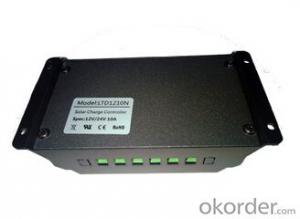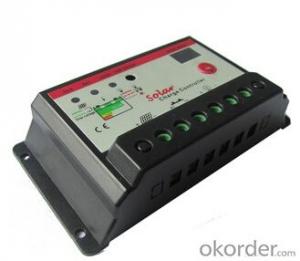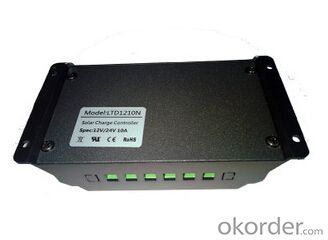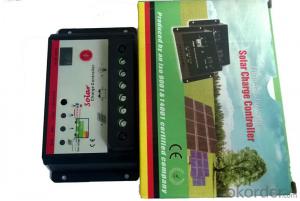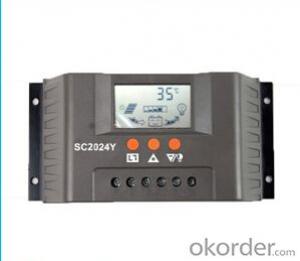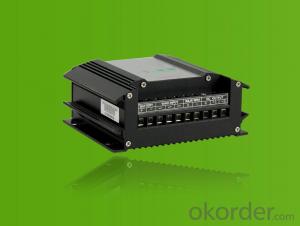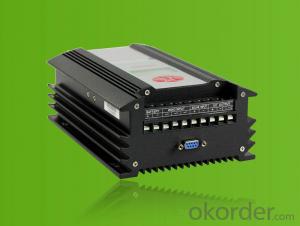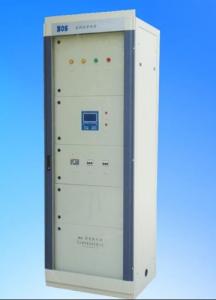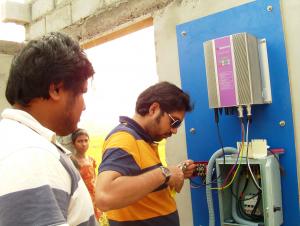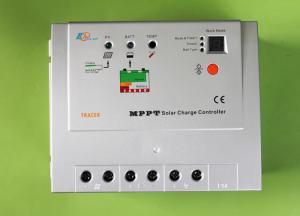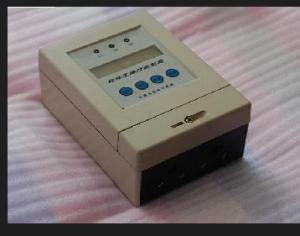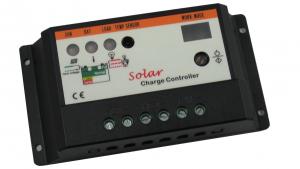Rv Solar Controllers for Sale - BYGD Solar Charger Controller Model SC3024S for Streetlight System
- Loading Port:
- Shanghai
- Payment Terms:
- TT OR LC
- Min Order Qty:
- 10 unit
- Supply Capability:
- 50 unit/month
OKorder Service Pledge
OKorder Financial Service
You Might Also Like
Details of products:
product model: SC3024S 30A
External Size:133mm×70mm
Mounting hole Size:126mm×50mm
Performance
12V/24V automatical adaption, control and set button changed into tact key, larger contact terminal can offer wire of 6 m2
◆ double LED digital display, clear for observation
◆ recharging mode by three phases
◆ PWM pulse modulated recharging technology
◆set light-dependent control and 1-13hous time control
◆short circuit protection, overvoltage protection, overcurrent protection and lighting protection
◆standy current no more than 5mA
example
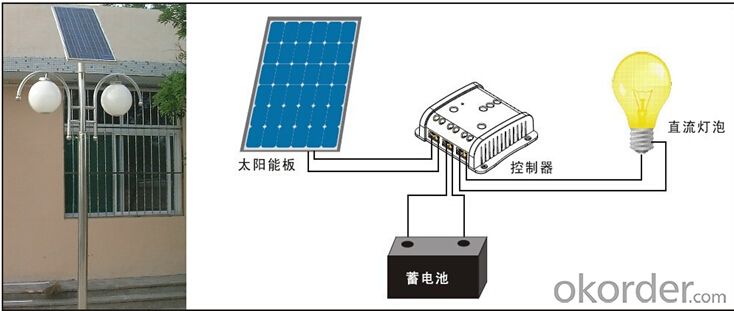
Technical characteristics
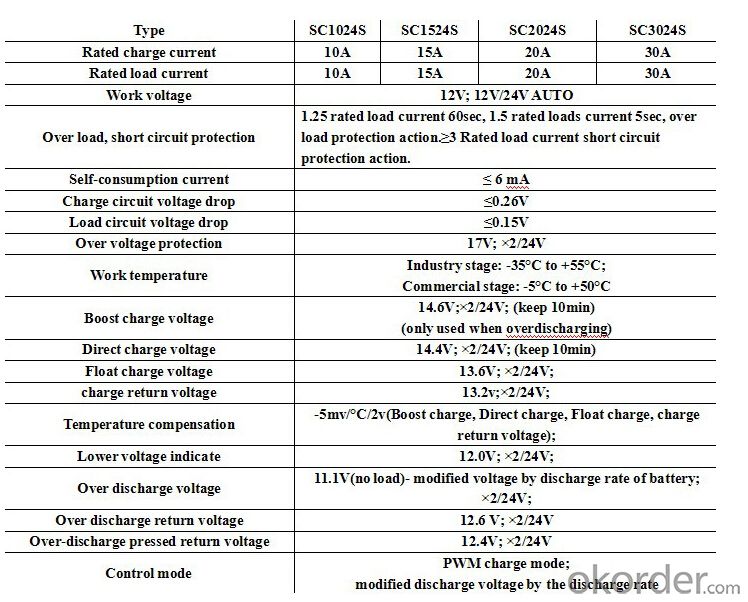
P.S.: This product is manufactured by order, so please call us for more info and service
- Q: Can a solar controller be used with a solar hybrid system?
- Yes, a solar controller can be used with a solar hybrid system. A solar controller is responsible for regulating the charging and discharging of batteries in a solar system. In a hybrid system, which combines solar power with other sources like wind or grid electricity, a solar controller plays a crucial role in managing the flow of energy between different sources and ensuring efficient battery usage.
- Q: What is the maximum cable length between solar panels and a solar controller?
- The maximum cable length between solar panels and a solar controller depends on various factors such as the type of cables used, the voltage drop tolerance, and the specific solar controller's specifications. Generally, it is recommended to keep the cable length below 100 feet (30 meters) to minimize power loss and ensure efficient operation. However, it is crucial to consult the manufacturer's guidelines or consult with a professional installer to determine the maximum cable length suitable for your specific setup.
- Q: How does a solar controller prevent damage to the solar panels from fire hazards?
- In several ways, a solar controller prevents damage to solar panels caused by fire hazards. Firstly, it regulates the power flow from the panels to the battery or load by monitoring their temperature, preventing overheating. If the temperature surpasses a certain threshold, the controller can decrease the charging current or disconnect the panels entirely to prevent further heating. Moreover, a solar controller comes equipped with built-in protection mechanisms like over-voltage and over-current protection. These features ensure that the panels don't generate excessive voltage or current that could pose a fire hazard. The controller constantly monitors the voltage and current levels, automatically shutting down the charging circuit if any irregularities are detected, thus preventing any potential harm to the panels. Furthermore, a solar controller also includes short-circuit protection. If a short circuit occurs in the wiring or load, the controller promptly detects the abnormal current flow and interrupts the circuit to prevent any potential fire hazards. This feature guarantees that the panels aren't exposed to dangerous levels of current that could cause overheating and subsequent damage. Overall, a solar controller functions as a crucial safety measure by continuously monitoring the temperature, voltage, and current levels of the solar panels. By regulating and protecting against excessive heat, voltage, or current, it prevents damage to the panels and significantly decreases the risk of fire hazards.
- Q: Can a solar controller handle different battery types (lead-acid, lithium-ion, etc.)?
- Yes, a solar controller can handle different battery types including lead-acid, lithium-ion, and others. However, it is important to choose a solar controller that is compatible with the specific battery type being used to ensure optimal charging and performance.
- Q: Can a solar controller be used with solar-powered electric fences for wildlife conservation?
- Solar-powered electric fences for wildlife conservation can indeed utilize a solar controller. The solar controller plays a vital role in regulating the flow of electricity from the solar panels to the fence, making it an indispensable part of the system. Its primary function is to ensure that the fence receives the appropriate voltage and current, effectively deterring wildlife while minimizing energy consumption. By doing so, the solar controller enables the fence to operate optimally, achieving its intended purpose of wildlife conservation. The solar controller offers various features specifically designed for wildlife conservation. One notable feature is the inclusion of built-in timers, allowing the fence to activate only during specific periods, such as nighttime when predators are most active. This feature not only saves energy but also extends the battery's lifespan by preserving the stored solar energy. Additionally, solar controllers often possess low voltage disconnect (LVD) capabilities. When the battery's charge drops below a predetermined level, the controller automatically disconnects the fence, preventing excessive discharge of the battery. This safeguard protects the battery and ensures that the fence remains functional when required. Moreover, certain solar controllers offer remote monitoring and control capabilities, enabling wildlife conservationists to remotely monitor the fence's status and make necessary adjustments. This feature proves particularly advantageous in managing fences located in remote or inaccessible areas, where physical inspections pose challenges. In conclusion, the solar controller assumes a critical role in solar-powered electric fence systems for wildlife conservation. Its presence guarantees the optimal functioning of the fence, maximizes energy efficiency, and safeguards the battery. Furthermore, the advanced features of select solar controllers provide flexibility and remote control capabilities, making them highly suitable for wildlife conservation purposes.
- Q: How do I calculate the maximum load output current for a solar controller in a grid-tied system?
- In order to determine the maximum load output current of a solar controller in a grid-tied system, several factors need to be considered. Firstly, one must ascertain the maximum power output of the solar panels. This information is typically provided by the manufacturer and can be found in the panel specifications. Let us assume that the solar panels have a maximum power output of 300 watts. Subsequently, the voltage of the grid-tied system needs to be determined. This is usually the standard voltage of the electrical grid in one's country, such as 120 volts or 240 volts. To calculate the maximum load output current, the following formula can be used: Maximum Load Output Current = Maximum Power Output / Voltage For instance, if the solar panels have a maximum power output of 300 watts and the grid-tied system operates at a voltage of 240 volts, the calculation would be as follows: Maximum Load Output Current = 300 watts / 240 volts = 1.25 amps Hence, the maximum load output current for the solar controller in a grid-tied system would be 1.25 amps. It should be noted that this calculation assumes ideal conditions and does not take into consideration any losses or inefficiencies in the system. It is always advisable to consult the manufacturer's specifications and guidelines for the specific solar controller in order to ensure accurate calculations and safe operation.
- Q: Can a solar controller be used with a solar-powered government building?
- Yes, a solar controller can be used with a solar-powered government building. A solar controller is an essential component of a solar power system as it helps regulate the flow of electricity from the solar panels to the building's electrical system. It ensures that the solar panels are operating efficiently and that the building is receiving the optimal amount of power. Therefore, a solar controller is necessary for managing and maximizing the energy output of a solar-powered government building.
- Q: What are the different types of solar controllers?
- The different types of solar controllers include PWM (Pulse Width Modulation) controllers and MPPT (Maximum Power Point Tracking) controllers.
- Q: What is the maximum charging time that a solar controller can provide?
- The maximum charging time that a solar controller can provide is largely dependent on the capacity and efficiency of the solar panels and the battery being charged. Solar controllers, also known as charge controllers, regulate the amount of charge flowing into the battery from the solar panels. In ideal conditions, where there is ample sunlight and the solar panels are operating at their maximum efficiency, a solar controller can continue to charge the battery until it reaches its maximum capacity. However, this can vary based on factors such as the size and type of battery, the available sunlight, and any additional loads or power requirements. It's important to note that solar controllers are designed to prevent overcharging and damage to the battery. Once the battery reaches its maximum charge, the solar controller will stop charging or divert excess energy to a different load, such as powering devices or feeding back into the grid. Ultimately, the maximum charging time of a solar controller is determined by the specific system components and environmental conditions. It is recommended to consult the manufacturer's specifications and guidelines for the solar controller and battery being used in order to determine the maximum charging time.
- Q: What is the maximum charging current for a solar controller?
- The maximum charging current for a solar controller varies depending on the specific model and its capabilities. It can range from a few amps to several tens of amps, depending on the capacity and design of the solar controller.
Send your message to us
Rv Solar Controllers for Sale - BYGD Solar Charger Controller Model SC3024S for Streetlight System
- Loading Port:
- Shanghai
- Payment Terms:
- TT OR LC
- Min Order Qty:
- 10 unit
- Supply Capability:
- 50 unit/month
OKorder Service Pledge
OKorder Financial Service
Similar products
Hot products
Hot Searches
Related keywords
